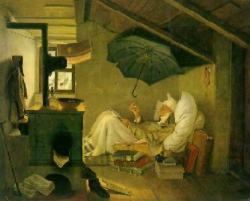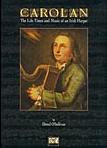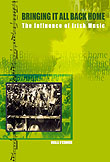T:-)M's Night Shift
Of Irish Harps and Celtic Synths - Read by Walkin' T:-)M
 If I raise my head and
lift up my body a little bit, I'm just able to see over the stacks of books
surrounding my chaise longue. That's too much. Inquiries about the
spirit of music among Indonesian man-eaters. Tutors teaching the singing chain-saw
and Righteous Christian dancing (approved by both the Pope and Ian Paisley).
Books you already know before you even turn the first page. Surely, a third
of all can be given away before reading, another third right after ... But let's
have a look at what's been left behind!
If I raise my head and
lift up my body a little bit, I'm just able to see over the stacks of books
surrounding my chaise longue. That's too much. Inquiries about the
spirit of music among Indonesian man-eaters. Tutors teaching the singing chain-saw
and Righteous Christian dancing (approved by both the Pope and Ian Paisley).
Books you already know before you even turn the first page. Surely, a third
of all can be given away before reading, another third right after ... But let's
have a look at what's been left behind!
Way back in 1989, I went to Dublin and purchased the four volumes of "Folk
Songs and Ballads Popular in Ireland" (of course, that wasn't the only reason
to go to Dublin). I never looked back since, as they say, and I still hold this
collection of Irish songs in high esteem. Ossian Publications, founded by Dutchman
John Loesberg in 1969, generally has an impressive catalogue of song and tune
books, tutors and reprints. The latest addition is Donal O'Sullivan's Carolan
- The Life, Times and Music of an Irish Harper (see also).
Turlough O'Carolan (Toirdhealbhach
Ó Cearbhalláin) was born in 1670 near Nobber, County Meath. Around the age of
18 he was blinded by smallpox. Carolan studied the harp and his patron Mrs.
MacDermott Roe gave him a horse and a companion to begin a career as an itinerant
harper. For forty-five years he would travel throughout Ireland composing tunes
for the Gaelic and Anglo-Irish aristocracy of the time.  Inhospitality he never pardoned, as the epitaph on a mean ale-wife testifies:
Inhospitality he never pardoned, as the epitaph on a mean ale-wife testifies:
"I beg and pray you, tomb, do not let Bridget out,
Or she would make your drink bitter and bring shame on your house;
She has brought death by thirst to many a faultless sage,
And now that you are in the grave,
Eternal damnation to you - and thirst, thirst, thirst!"
In 1738, feeling ill, Carolan returned to the home of Mrs. MacDermott Roe. He
called for his harp and played his final piece "Farewell to Music".
Carolan was buried in Kilronan churchyard,
Co. Roscommon. His skull was placed in a niche and used as a cure for epilepsy
for some time, until it disappeared into oblivion.
A significant number of tunes survived. Carolan wasn't the most skillful of
performers, but he had a gift for composition and verse. He created a unique
style by combining the Gaelic art music of the harp and folk melody with the
music of contemporary Italian composers: Vivaldi, Corelli, and Geminiani.
O'Sullivan's classic study about Signor Carrollini has been originally
published in 1958, including an essay on the life of Carolan, 213 tunes and
their annotations, as well as the memoirs of harper Arthur O'Neill.
The re-issue contains some additional tunes and details unearthed by American
harper Bonnie Shaljean.
"In an age of pallid gloom for Ireland, this blind harper brought
something new to his country's music, a kind of puckish joyousness which before
it had seemed to lack, with here and there a sunbeam captured from the perennial
sunshine of Italy." (O'Sullivan)
Irish music moved on since Carolan's days. It was carried across the Atlantic
by those driven by oppression, poverty, hunger, or sheer wanderlust. The Irish
were the immigrant group which contributed most to American folklore. The music
of the early settlers changed and fusioned to become old time, country, bluegrass,
and early rock'n'roll. Irish-Americans introduced the minstrel shows
and wrote songs like "Dixie" and "Give my Regards to Broadway". Chief O'Neill made his
famous collection of Irish tunes, master musicians like fiddler Michael
Coleman or piper Patsy Touhey
recorded on 78 rpms.
The music again travelled to and fro across the Western Ocean. One day in
1953, Sarah Makem
was visited in her native Keady in Co. Armagh by American singer and song collector
Jean Ritchie:
"I have a wonderful recording of her getting supper or tea for us
while she's singing and talking to us ... she's singing, you can hear the knife
go through the bread - rar! rar! rar! - and you can hear the bacon sizzling.
 All the time
she's singing As I roved out on a May morning, on a May morning right early.
I kept listening to it and smelling the bacon and being reminded of something
... it was a play game that we played back home [in Kentucky]; it was called
`Old King Cole was a Jolly Old Soul' and it used almost the same tune as she
was using. So that's how the music got there! Sometimes the words were changed
but the tune remained the same. They had a way of keeping the Irish tunes because
the Irish tunes were far superior, of course! ... [Sarah] went to all the shops
to spread the word, and we had a party. That evening, Sarah's son Tommy, who
was about seventeen, played the tin whistle for us. At the time he knew only
one tune, but he got interested in the old songs as a result of our visit. After
that, we learned that he went around to the neighbours saying sing me all
the songs you know."
All the time
she's singing As I roved out on a May morning, on a May morning right early.
I kept listening to it and smelling the bacon and being reminded of something
... it was a play game that we played back home [in Kentucky]; it was called
`Old King Cole was a Jolly Old Soul' and it used almost the same tune as she
was using. So that's how the music got there! Sometimes the words were changed
but the tune remained the same. They had a way of keeping the Irish tunes because
the Irish tunes were far superior, of course! ... [Sarah] went to all the shops
to spread the word, and we had a party. That evening, Sarah's son Tommy, who
was about seventeen, played the tin whistle for us. At the time he knew only
one tune, but he got interested in the old songs as a result of our visit. After
that, we learned that he went around to the neighbours saying sing me all
the songs you know."
Tommy Makem subsequently joined forces with
the Clancys and folk music was never the same
again.
Bringing It All Back Home was a five-part documentary film series by
BBC and RTE in 1991, tracing the journey of traditional
Irish music from its earliest recorded history to the present day, how it changed
in the course of history, but stayed true to its own at the very same time.
But author Nuala O'Connor covers the whole story of Irish music going back in
time Considering it's only about 150 pages thick, she provides a wealth of information
and gives a comprehensive view on what has shaped today's folk and trad scene.
Well, nowadays Ireland is regarded being just one link in the Celtic Connection.
Irish music is certainly the most famous, Wales is virtually unknown. But what
is Celtic music anyway? Kenny Mathieson gives the answer in Celtic Music
- The Essential Listening Companion:
"If anything, it is a marketing strategy - and a very successful one.
A less cynical and more practical answer is that it is the music produced in
the so-called Celtic countries, drawing on the traditional musical culture of
those countries, namely: Ireland, Scotland, Wales, the Isle of man, Cornwall,
Brittany, and Celtic Iberia ... A fashion for a kind of pseudo-Celtic new age
mysticism is not given much credence in this book ..."
That's fine. Kenny and his team lead the reader on a tour de force from the
1960's folk revival onwards. The book is divided into territorial sections,
subdivided into categories of voice, pipes, fiddle, others, and bands. Every
important group or single musician - from Welsh Aberjaber and
Irish Afro Celts to French Gabriel Yacoub and the Canadian 78th
Fraser Highlanders - is treated within a short paragraph. There's photographs,
record sleeves, and recommended recordings as well. It's very concise, newspaper
style, but the information given is reliable - and you can't say that of anything
termed Celtic in these days.
Finally, contributor Sue Wilson points us into new directions: 
"If Celtic music has proved one thing during its long and eventful
history, it is that it is a cultural survivor. Its ability to recapture the
imagination of successive generations has again been comprehensively demonstrated
in the international upsurge of popular interest that has revitalised the Celtic
scene around the turn of the 21st century ... The most salient and dynamic feature
of this new Celtic flowering is the proliferating incidence of cross-genre or
cross-cultural experimentation. Traditional Celtic modes and material are mixed
and matched with everything from improvised jazz to electronic dance music,
Scandinavian and East European styles, and on to Latin, African and Caribbean
influences ..."
But that's already another story. So see you again soon, T:-)M.
Mathieson, Kenny (ed.), Celtic Music. The Essential Listening Companion.
Backbeat, San Francisco, 2001, ISBN
0-87930-623-8, Paperback, 192 pp, US$19,95.
O'Connor, Nuala, Bringing It All Back Home. The Influence of Irish Music
at Home and Overseas. Merlin, Dublin, 2001, ISBN 1-903582-03-2,
Paperback, 162 pp, EUR17.76.
O'Sullivan, Donal, Carolan. The Life, Times and Music of an Irish Harper.
Ossian, Cork, 2001, ISBN 1-900428-71-7,
Paperback, 384 pp, £27.95 (Hardcover IRP35.95).
Back to the content of FolkWorld
Articles, Live Reviews & Columns
To the content of FolkWorld
online magazine Nr. 20
© The Mollis - Editors
of FolkWorld; Published 12/2001
All material published in FolkWorld is © The
Author via FolkWorld. Storage for private use is allowed and welcome. Reviews
and extracts of up to 200 words may be freely quoted and reproduced, if source
and author are acknowledged. For any other reproduction please ask the Editors
for permission.
FolkWorld - Home of European Music

Layout & Idea of FolkWorld © The
Mollis - Editors of FolkWorld
 If I raise my head and
lift up my body a little bit, I'm just able to see over the stacks of books
surrounding my chaise longue. That's too much. Inquiries about the
spirit of music among Indonesian man-eaters. Tutors teaching the singing chain-saw
and Righteous Christian dancing (approved by both the Pope and Ian Paisley).
Books you already know before you even turn the first page. Surely, a third
of all can be given away before reading, another third right after ... But let's
have a look at what's been left behind!
If I raise my head and
lift up my body a little bit, I'm just able to see over the stacks of books
surrounding my chaise longue. That's too much. Inquiries about the
spirit of music among Indonesian man-eaters. Tutors teaching the singing chain-saw
and Righteous Christian dancing (approved by both the Pope and Ian Paisley).
Books you already know before you even turn the first page. Surely, a third
of all can be given away before reading, another third right after ... But let's
have a look at what's been left behind!  Inhospitality he never pardoned, as the epitaph on a mean ale-wife testifies:
Inhospitality he never pardoned, as the epitaph on a mean ale-wife testifies:
 All the time
she's singing As I roved out on a May morning, on a May morning right early.
I kept listening to it and smelling the bacon and being reminded of something
... it was a play game that we played back home [in Kentucky]; it was called
`Old King Cole was a Jolly Old Soul' and it used almost the same tune as she
was using. So that's how the music got there! Sometimes the words were changed
but the tune remained the same. They had a way of keeping the Irish tunes because
the Irish tunes were far superior, of course! ... [Sarah] went to all the shops
to spread the word, and we had a party. That evening, Sarah's son Tommy, who
was about seventeen, played the tin whistle for us. At the time he knew only
one tune, but he got interested in the old songs as a result of our visit. After
that, we learned that he went around to the neighbours saying sing me all
the songs you know."
All the time
she's singing As I roved out on a May morning, on a May morning right early.
I kept listening to it and smelling the bacon and being reminded of something
... it was a play game that we played back home [in Kentucky]; it was called
`Old King Cole was a Jolly Old Soul' and it used almost the same tune as she
was using. So that's how the music got there! Sometimes the words were changed
but the tune remained the same. They had a way of keeping the Irish tunes because
the Irish tunes were far superior, of course! ... [Sarah] went to all the shops
to spread the word, and we had a party. That evening, Sarah's son Tommy, who
was about seventeen, played the tin whistle for us. At the time he knew only
one tune, but he got interested in the old songs as a result of our visit. After
that, we learned that he went around to the neighbours saying sing me all
the songs you know." 
